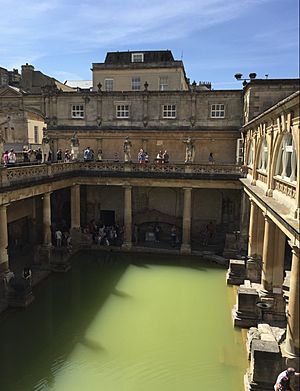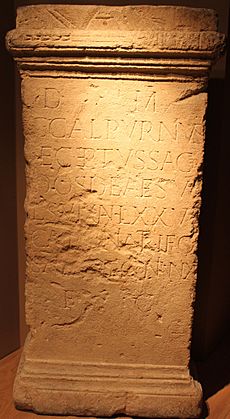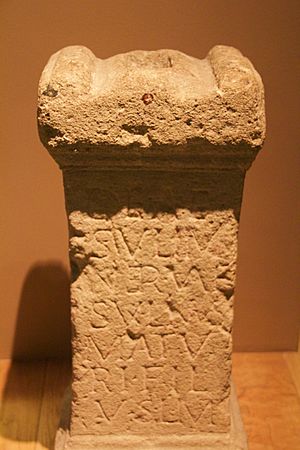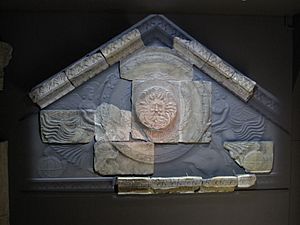Sulis facts for kids
Quick facts for kids Sulis |
|
|---|---|
| Goddess of Healing, water, hot springs and curses | |
| Major cult centre | Bath (Aquae Sulis) |
| Equivalents | |
| Roman equivalent | Minerva |
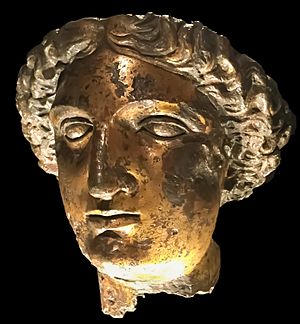
Sulis was an important goddess in ancient Britain. People worshipped her at the hot springs in Bath. The Romans, who later came to Britain, called her Sulis Minerva. People believed she was a goddess of healing, water, and hot springs. They also thought she could help with special requests or even curses. Many ancient objects and written messages show how people honored her.
Contents
What Does the Name Sulis Mean?
The name Sulis has been studied by many experts. Most agree it might mean "eye" or "sight."
Some also think it could be linked to ancient words for "sun." This would connect Sulis to the sun itself. Another idea is that Sulis means "good to see." This comes from combining "good" with "to see" in an old Celtic language.
You can still find the name Sulis today. For example, the old Welsh name Sulgen (meaning "born from Sulis") and the Breton name Sul are related to her.
Worshiping Sulis at Bath
Sulis was the special goddess of the hot springs in Bath. The Romans called this place Aquae Sulis, which means "the waters of Sulis." People believed Sulis could heal them. Her sacred hot springs were thought to cure sickness or help with problems.
Worship of Sulis in Bath was popular for a long time. Her name is mostly found on writings from her temple in Bath. Only one mention of her has been found outside of Britain, in Germany.
At the Roman temple in Bath, people offered gifts to Sulis. They might have used the open area around the altar for ceremonies. They would offer food and drinks to the goddess. Many coins have been found in the spring, over 12,500 Roman coins and 18 Celtic coins. People also left jewelry, gemstones, plates, and even military items as private gifts.
Some metal cups found in the spring suggest people used them to pour the water over their bodies. They believed this would help transfer the healing power of the water.
Writings found at the site show that visitors included soldiers. Some were retired, others were tourists, or seeking healing for injuries. People who could afford to leave inscriptions were likely important.
The Temple to Sulis Minerva used coal for its altar fires, not wood. Slaves or servants would bring the coal. They also helped with cleaning and preparing meals for religious gatherings.
The golden bronze statue of Sulis Minerva was damaged long ago. This might have been done by invaders or early Christians.
Messages to Sulis: Curse Tablets
About 130 special messages, called curse tablets, have been found in the sacred spring at Bath. Most of these messages were sent to Sulis. They often asked her to punish thieves. For example, someone might ask Sulis to punish whoever stole their money or clothes from the bath-house.
These tablets were written in a special kind of Latin. This shows that many local people wrote them. The messages asked Sulis to harm the thief until the stolen items were returned. They might ask her to stop the thief from sleeping or even cause them to die. The suffering would end only when the property was given back or dedicated to Sulis.
One tablet found in the temple said: "Docimedis has lost two gloves. He asks that the thief should lose their mind and eyes in the goddess' temple."
Sometimes, the tablets were written in code. Letters or words might be backward. The lines could even be written in different directions. Most texts from Roman Britain are in Latin. However, two tablets found here are in an unknown language. It might be an ancient British language. These are the only examples of writing in that language ever found.
One tablet is dated, but without a year. Experts can guess the year by comparing the handwriting to other tablets. This shows that people used these tablets for at least 200 years. This means they truly believed in their power.
Sulis and Minerva: A Combined Goddess
At Bath, the Roman temple was dedicated to Sulis Minerva. It is likely that people worshipped Sulis in Bath before the Romans arrived. The local Celtic tribe, the Dobunni, probably believed Sulis had healing powers. The discovery of 18 Celtic Iron Age coins at the site supports this idea. This is why Sulis is named first in "Sulis Minerva."
Because Sulis was linked with the Roman goddess Minerva, some later writers thought Sulis was also a goddess of wisdom.
Many altars and bases found at the Roman temple in Bath mention Sulis Minerva. For example, one altar says: "To the goddess Sulis Minerva Sulinus, son of Maturus, willingly and deservedly fulfilled his vow."
Sulis was not the only Celtic goddess combined with Minerva. Other goddesses like Senua and Brigantia also shared traits with Minerva. It was common for Roman gods to be linked with many Celtic gods. However, it was less common for Celtic goddesses to be combined with Roman goddesses. Sulis Minerva is one of the few examples.
Dedications to "Minerva" are common in Britain and Europe. Most do not include a Celtic name.
Sulis as a Sun Goddess
Based on her name and other clues, Sulis might have been a sun goddess before the Romans came. She was linked to sight and light. Some researchers think she was the main Celtic sun goddess. Other similar names found elsewhere might also refer to her.
Sulis in Modern Times
Today, some people who follow Wicca and pagan traditions still worship Sulis. In 1998, some visitors still left offerings in the Roman baths. The Roman Baths Museum now encourages visitors to throw coins into the Circular Bath. These coins are collected and used to help fund archaeological work in Bath.
Sulis in Art and Ancient Writings
Sulis Minerva's Head
A golden bronze head of Sulis Minerva was found in Bath in 1727. This head (see top right) was likely part of a large statue. The statue probably stood inside her temple, near the sacred spring. It might have been made when the Roman site was first built, around the late 1st century CE. Only two other golden bronze finds from Roman Britain are known.
Temple Pediment and Gorgon's Head
This large stone carving, called a pediment, was found in 1790. It came from the Temple of Sulis Minerva. In its center is a big head, often called the Gorgon's head. It was probably carved in the 1st century CE by artists from northern Gaul. The pediment was very tall, about 15 meters high. It was supported by four columns.
One idea is that the central head shows the mythical Gorgon. In Greek myths, the hero Perseus killed the Gorgon. He gave her head to Athena, who wore it on her armor. Since Minerva is the Roman version of Athena, this could link the Gorgon to Sulis Minerva. Even though the Gorgon on the pediment looks male, it might be a mix of Celtic and classical styles.
Another idea is that the central head represents a water god. It looks similar to other water gods from Britain. For example, a silver dish from Mildenhall shows the god Oceanus.
In 2016, a researcher named Eleri H. Cousins suggested that many images on the pediment are like those used by Roman emperors. These include the winged figures of Victory and the oak wreath. She also pointed out similar carvings in Gaul and Spain. This suggests the Forum of Augustus in Rome might have been a model. Cousins believes the pediment mixes Roman and Celtic styles. It combines ideas from local traditions and the wider Roman Empire.
Altar-like Statue Base
An altar-like statue base was found near the steps of the Temple for Sulis Minerva. The writing on it says: "To the goddess Sulis, Lucius Marcius Memor, soothsayer, gave (this) as a gift." This is the only known record of a haruspex (a priest who read animal insides to predict the future) from Britain. The original writing used a short form for haruspex. Later, more letters were added to make it clearer. This might mean Memor was not part of the temple staff. He might have been a visitor from the governor's team.
Altar-like Tombstone
This tombstone, which looks like an altar (see top left), was found outside Bath. It was with two urns holding ashes. The tombstone reads: "To the spirits of the departed; Gaius Calpurnius Receptus, priest of the goddess Sulis, lived 75 years; Calpurnia Trifosa, his freedwoman (and) wife, had this set up." Receptus' wife, Trifosa, had a Greek name meaning "De Luxe." She was likely a slave before she was freed and married her former owner, Receptus.
Sulis in Books and Stories Today
Sulis has inspired many writers and storytellers.
Here are some historical fiction books where Sulis and the Roman Baths appear:
- The Waters of Sul (1989) by Moyra Caldecott
- Flavia's Secret (2008) by Lindsay Townsend
- Crown of Acorns (2010) by Catherine Fisher
- The Curse-Maker (2011) by Kelli Stanley
- Memento Mori: A Crime Novel of the Roman Empire (2018) by Ruth Downie
- The Sinister Booksellers of Bath (2023) by Garth Nix
See also
- List of solar deities
- Solsbury Hill
- Water and religion


